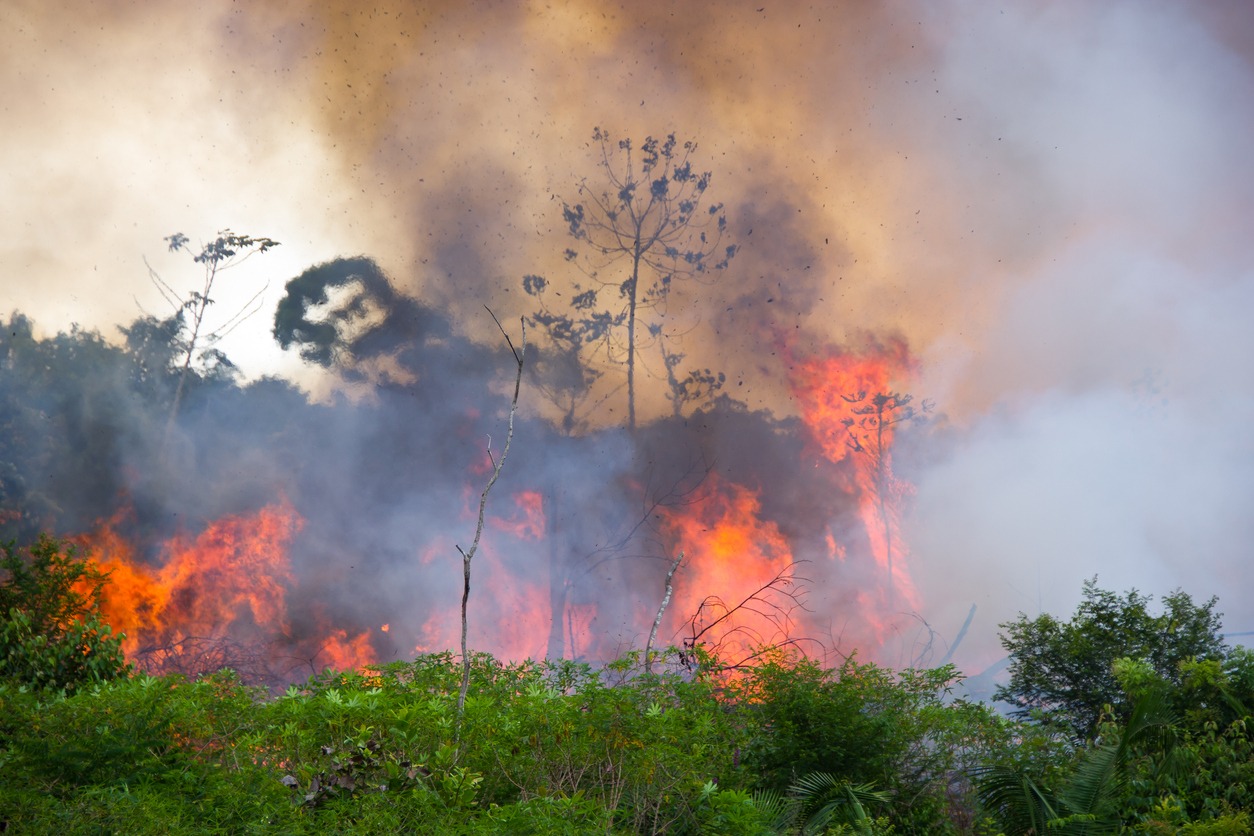It’s all over the news and can be seen from space. The Amazon Rainforest has been burning for three weeks and counting. The 39,000 fires across the biodiversity hotspot this year is a new record, but it’s not one to be celebrated.
While Brazil’s government finally took action this week, sending warplanes to dump water on the fires, there’s likely to be significant damage to the home of 10% of the world’s animal and plant species.
“…strong indication of the intentional character of the fires”
Photos released by Greenpeace Brazil on August 25 suggest that fires were set intentionally for forest-clearing purposes. The group blames the policies of Brazil’s ring-wing populist President Jair Bolsonaro, who has reportedly encouraged ranchers, farmers, loggers, and miners to clear forests.
“It’s urgent and necessary to put an end to this vicious cycle while we still have time,” said Danicley Aguiar, an Amazon campaigner at Greenpeace Brazil in an official statement.
IPAM Amazônia, a Brazilian research group, too, has connected the dots. Their latest report showed that the 10 Amazonian municipalities that had the most fire outbreaks this year also had the highest deforestation rates. “This concentration of forest fires in newly deforested areas with mild drought represent a strong indication of the intentional character of the fires,” it said.
It’s not just the Amazon that’s burning.
Lands across the world are also burning at the same time. On August 18, a wildfire in the Canary Islands forced more than 8,000 people to abandon their homes. More than 21,000 square miles of forest have gone up in flames in Siberia just this month.
Over here in APAC, 60 hectares of forest in southern Malaysia are in flames, triggered by dry weather, causing respiratory problems for neighboring Singapore.
The US state of Alaska is also enduring a new spate of wildfires, extending what’s already been an unusually lengthy fire season for the state.
Luckily, California’s 2019 wildfires were a fraction of 2018’s carnage, where nearly 2 million acres burned involving several fatalities, but the threat of such widespread destruction lingers.
With our focus on technology here at AFN, we started to wonder what role could existing tech have played in halting or preventing such disasters. Particularly as the risk of such blazes is unlikely to go away, with the world’s temperatures continuing to rise.
Meat is forest murder? Perhaps Beyond Meat & Co. is the way to go.
A big culprit of deforestation is the meat industry, as lands are often cleared to grow soy to feed cattle or for pasture to raise them on.
CNN and The Independent are among several news sources that point the accusatory finger at carnivores. The former echoes the claim by Greenpeace Brazil that Bolsanaro encouraged loggers and ranchers to torch forests to clear land for cattle, saying he’s “backed by the country’s so-called ‘beef caucus’.” Meanwhile, The Independent said Brazil is “home to around 200 million cows, and is the largest exporter in the world, supplying one-quarter of the global beef market”.
Can plant-based meat alternatives help? Perhaps. A bunch of Wall Street bankers at UBS think so.
“On average, plant-based burgers from Impossible (Foods) and Beyond (Meat) generate 89% less greenhouse gas emissions, require 94% less land, and have a 93% smaller water footprint,” the report said.
It goes on to add that “plant-based burgers offer consumers a way to sidestep red meats,” and paints a bullish picture on innovation in alt-protein. “Smart capital can play a critical and profitable role in funding these advances. We forecast food innovation will grow to a $700 bn market by 2030 – a fivefold jump from today,” concludes the report.
(A word of caution: many plant-based “meat” offerings are based on soy as the main ingredient; the same soy that’s fed to cattle and grown on such deforested land. Further, they often only use a soy extract so there are also considerations around waste to bear in mind.)
How about planting a tree for every one burnt?
Celebs like Vanessa Hudgens, Leonardo DiCaprio, and Lana Condor have supported relief efforts.
It’s definitely not a competition, but the Titanic superstar’s environmental initiative called Earth Alliance edged the rest of the bunch out when it pledged $5 million to Amazon relief.
Sure. As individuals, we don’t have millions of dollars to help relief efforts for rainforest, even though we would if we could.
So, how can we help?
Ecosia, a German startup with an internet search engine, is one answer – as my editor, Louisa, recently found out. In February, the company said it had raked in enough money to plant 50 million trees. This equates to the removal of 2.5 million tonnes of Co2 from the atmosphere. So, every time we make a search on their site, we contribute to their tree-planting efforts. They partner with Bing, Microsoft’s search engine, to get results for users, but receive a majority portion of any revenues. After covering its internal costs, everything left goes towards planting trees; Ecosia is a non-profit organization.
Ecosia is planting a tree every second in Kenya, Brazil, Indonesia, Spain, Tanzania, Madagascar, Colombia, Peru, Senegal, Burkina Faso, Haiti, Morocco, Ethiopia, Uganda, Ghana and Nicaragua.
Drones, not just for images
Drones are used in all sizes, shapes, and functionalities in agtech – be it to spread fertilizer, water plants, monitor their growth, and even help out bees in mass pollination.
But this drone can hold nearly double the capacity of a Bell 206 helicopter in water. Spanish startup Drone Hopper has developed a remote-controlled aircraft that comes with a container unit to hold liquids that can be used to douse flames. Their largest model, the Wild Hopper, has a capacity of 160 gallons.
The drone comes armed with a release mechanism that converts the water into small water drops. After which, it mixes the mist with air, creating a wet airflow that suffocates fires by cutting the oxygen flow, depriving them the fuel they need to keep on burning.
On top of ferrying firefighting tech, drones can be fitted with both regular and thermal imaging cameras and can fly into areas where humans or manned aircraft can’t.
Workswell is one such startup that’s created a thermal camera attachable to drones and uses long-wave infrared radiation to ensure ‘vision’ through smoke.
Detection is the first step to action
Satellites are what one would liken to a giant drone (and even an early inspiration for it). Former NASA scientists-founded Planet, which uses its network of over 150 satellites to “image anywhere on Earth” typically used to monitor daily crop growth, boost yields, and even verify zero-deforestation commitments.
Planet recently entered a partnership to develop the California Forest Observatory, a platform that will provide a continuously updated view of wildfire risk in the state. It dynamically maps forest structure and fuel loads down to the tree level.
“The velocity of action is always limited by the velocity of information,” said Andrew Zolli, VP of Global Impact Initiatives at Planet. “By providing a much more dynamic, near-real-time view of California forests, we hope to enable many actors to move faster and more effectively.”
Axelspace, a Japanese space startup developing its own Earth imaging satellites, expresses confidence in their tech being able to alert authorities as soon as its tech detects a blaze.
“We believe that daily monitoring of the forest using our satellite can detect the forest fire early to mitigate the damage from spreading apart,” the startup’s Chief Business Officer, Yasunori Yamazaki, tells AFN.
What about the Internet of Things?
IoT (Internet of things), when applied in agritech, refers to the use of sensors, cameras, and other devices that turn every element and action involved in farming into data.
This includes weather, moisture, plant health, mineral status, chemical applications & pest presence. The data collected are then used to allow big data engineers to draw out insights about the farm at varying levels of granularity via software algorithms.
Combining drone tech with IoT is PrecisionHawk, which typically uses its tech to collect data by surveying and mapping farmland. Each of their drones can detect weather conditions using AI, collecting visual, thermal, and multispectral imagery, before landing in the same place it took off.
“With their bird’s eye view and advanced sensors, a drone can gather data on 500 to 1,000 acres in less than a day” – PrecisionHawk
Sensors are already being used to gather data from remote areas that are potential wildfire hotspots. They can be used to detect and measure the level of CO2 and check for unseasonably high temperatures, flagging the possible presence of fires in the area.
While it’s heartening to know that IoT solutions are already used by 10% to 15% of farmers, with a total expenditure of just under $1 billion, could this tech’s application extend to a forest the size of the Amazon?
Not enough manpower? Fine. Send robots.
Robots can keep humans out of harm’s way. Often wildfires get so hot that firefighters are unable to get close enough to extinguish them. But now, engineers have come up with a firefighting hunk of metal that can.
Colossus was the firefighting robot that helped turn the tide at the devastating fire at Notre Dame de Paris in April. It was developed by Shark Robotics, together with the Paris Fire Brigade.
But is unleashing an army of robots into the Amazon viable? We’ve reached out to Shark Robotics for comment.
Know of possible agtech that you think could help put out the blaze in the Amazon Rainforest? Drop me an email at [email protected].




